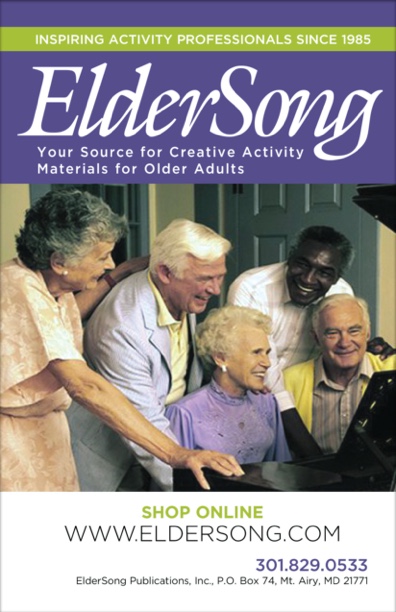Americans will soon be throwing a big birthday party, complete with picnics, parades, and fireworks. Fourth of July festivities are scheduled all across the nation, in rural communities, small towns, and large cities. No invitations are necessary for the red, white, and blue holiday. Just show up ready to celebrate the “land of liberty.” Here are patriotic activities for your group to join in the fun.
- INDEPENDENCE DAY: Share facts about Independence Day. Read some quotes from signers of the Declaration of Independence. Sing a few stanzas of some birthday songs: “America (My Country ’Tis of Thee),” “America the Beautiful,” or “God Bless America.” Ask participants to talk about 4th of July family traditions (ex: picnics, concerts, parades, fireworks). Describe what the midsummer holiday looks, sounds, smells, tastes, and feels like. Serve a red, white, and blue dessert.
- PICNIC: Display picnic props such as a wicker basket, utensils, and blanket. Plan a menu for an old-fashioned summer picnic. Suggest favorite places for a picnic. Reminisce about church picnics, family picnics, and company picnics. Share a simple picnic meal with the group. For entertainment, sing old American songs like these: “Take Me Out to the Ball Game,” “You Are My Sunshine,” “America the Beautiful,” “My Bonnie.”
- HOT DOGS: Celebrate National Hot Dog Month. Talk about the meaning of “as American as baseball, hot dogs, motherhood, and apple pie.” Learn how the hot dog got its name. Give other names for a hot dog (ex: footlong, wiener, frankfurter). Talk about favorite toppings. Taste different brands of hot dogs and vote on best-tasting. Discuss the meaning of “Hot dog!” as a slang word.
- MARCHING BANDS: Show a photo of a marching band. Ask: What is your favorite instrument to watch in a band? What other instruments can you identify in a band? Did you ever play in a marching band? How long were you in the band? Which instrument did you play? Invite an instrumentalist to demonstrate how to play (trumpet, trombone, clarinet, snare drum, etc.). Or, borrow some band instruments for an “instrument petting zoo.” Pass around instruments, or parts of instruments, for group members to hold. Play some of John Philip Sousa’s march music and march in place.
- MOVIE TIME: Watch the 1962 movie musical The Music Man, with Robert Preston and Shirley Jones. Hum along with the signature song “Seventy-six Trombones,” or march in place and wave a flag.
- PARADES: Display a large map of the United States and then ask participants to locate their hometown on the map. Ask: Do you enjoy parades? Have you ever participated in a local parade or helped to organize one? What do you recall about parades in your hometown as a youngster? Invite group members to assume the role of spectator at a 4th of July parade in their hometown. Who or what might they see in the parade? (Examples: high school band, floats, military veterans, Scout troops, baton twirlers, Little League team, politicians) Hold a small parade. Play rousing band music. Add some colorful hats, pennants on sticks, flags or banners to wave, and noisemakers. March around the room or through part of the facility.
- ART: Show participants a picture of the painting “Fourth of July” by Grandma Moses. (The original was given to the White House.) Then read the following to your group: “Anna Mary Robertson, known as Grandma Moses, discovered her love for painting in her seventies. The famous folk artist of the 20th century had her first New York show at age eighty. Some people achieve success and recognition later in life.” ASK: Do you know any “late bloomers”? What goals and dreams did you pursue later in life? What new experiences did you try in your golden years – new hobby, new sport, new language, new career? Tell us how to blossom in later life.
- WASHINGTON: Show a travel video of the nation’s capital, Washington, D.C. Pass around travel brochures, posters, postcards, and other memorabilia. Ask: Did your family ever take a trip to Washington, D.C.? When did you go? What did you see there? Did you ever celebrate Independence Day in D.C.? Talk about sightseeing in the nation’s capital. Or, assemble a variety of pictures of different buildings in Washington. Put the building’s official name on the picture. Show each picture and ask people to guess what is in the building. A variation: Ask questions such as Who lives in the White House? What is in the Smithsonian? Who works in the J. Edgar Hoover Building? What happened at Ford’s Theatre?
- COLLECTIONS: Discuss the meaning of “Americana.” Invite some collectors of Americana to share their objects with the group. (Examples: Depression glass, old coins, baseball cards, Norman Rockwell covers on The Saturday Evening Post) Ask participants if they ever bought or collected pieces of Americana, such as books, art, or period furniture.
- BOB HOPE: Pass around vintage photos of Bob Hope entertaining the troops through his USO camp shows. Ask: Did you or any member of your family ever see celebrities perform for service personnel during World War II, the Korean War, or Vietnam? Who do you remember in Bob Hope’s shows for the troops? What do you recall about USO canteens? How did you support the troops overseas or their families at home? Listen to Bob Hope’s signature tune “Thanks for the Memory.” Watch a video of one of Bob’s USO specials.
- GEORGE M: Celebrate the patriotic music of American composer George M. Cohan. Enjoy the tunes “The Yankee Doodle Boy,” “You’re a Grand Old Flag,” and “Over There” (all written in the early 1900s). Watch the 1942 musical movie Yankee Doodle Dandy, starring James Cagney as George M. Cohan.
- EAGLES: Invite a speaker from a local bird club to talk about the American bald eagle, which was adopted as our national symbol in 1782. Share the history behind the Great Seal of the United States of America.
- STATUE OF LIBERTY: Read Emma Lazarus’ 1883 sonnet “The New Colossus,” engraved on the Statue of Liberty. Invite a history buff to talk about Ellis Island and the Statue of Liberty. Ask participants to tell stories of immigrant ancestors. Share some 100-year-old family recipes from ancestors. Ask if anyone inherited a box of heirloom recipes from a relative.
- PATRIOTISM: Talk about the meaning of patriotism. Try to locate old copies of The Saturday Evening Post, Time, or LIFE with July 4th or other patriotic covers. Display the covers and ask your group what they recall about the decade or historical event on the cover of the magazine. Work a jigsaw puzzle with a patriotic scene.
- CRAFT: Make a patriotic flag wreath, using round Styrofoam and red, white, and blue tissue paper. (Check an online craft site for simple instructions.) Ask the participants what other decorations were used in their homes on patriotic holidays.
PATRIOTIC MUSIC TRIVIA QUIZ
- Who composed “The Stars and Stripes Forever,” the official march of the United States? John Philip Sousa
- What song was designated America’s national anthem in 1931? “The Star-Spangled Banner”
- Who are you likely to see when the Marine Band plays “Hail to the Chief”? Current U.S. president
- What is the official march of the U.S. Marine Corps? “Semper Fidelis”
- Which patriotic song mentions macaroni? “Yankee Doodle”
- Which patriotic song starts with ‘O beautiful for spacious skies, for amber waves of grain’? “America the Beautiful”
- Kate Smith first sang “God Bless America” on her radio program in 1938. Who wrote the song? Irving Berlin
- Which American folk singer wrote “This Land Is Your Land”? Woody Guthrie
- Where are you most likely to hear “Reveille” and “Taps”? In the armed services
- According to the song lyrics in “America” (Samuel F. Smith), what should ring ‘from every mountainside’? Freedom
THOUGHT FOR THE MONTH
“Be sure to put your feet in the right place, then stand firm.” ~ Abraham Lincoln
“PICNICS, PARADES, & PATRIOTISM” written by Sue Hansen. © 2013 ElderSong Publications, Inc. All rights reserved.
Reprint Policy: To reprint or republish all or portions of this entry, you must acquire written permission and agree to link back to the original source. Please contact us at [email protected] to obtain permission.


